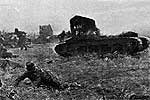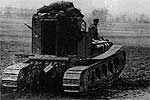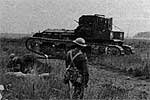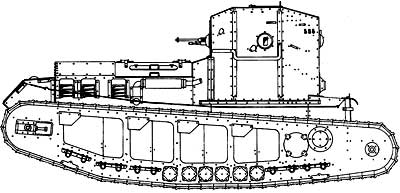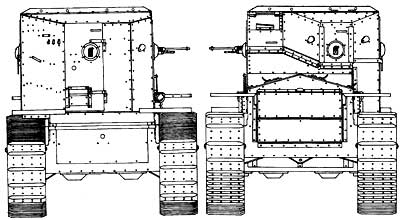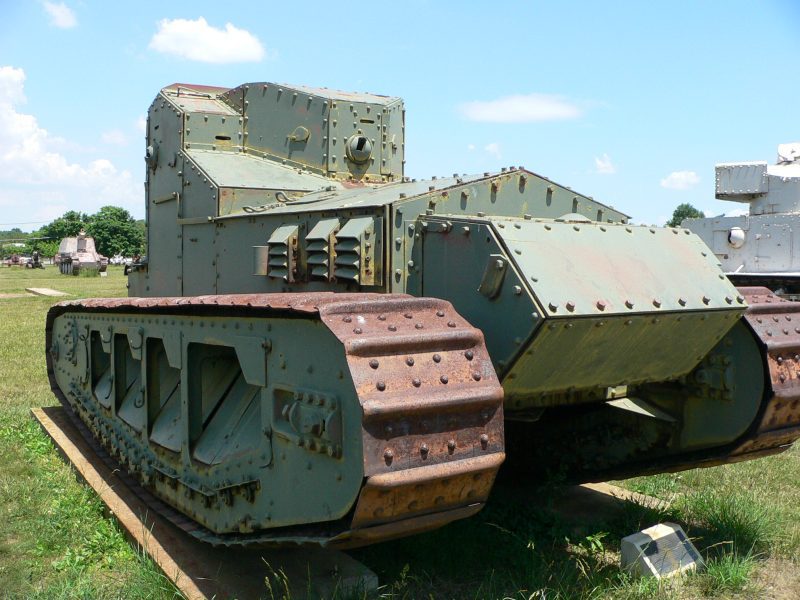
Medium tanks Mk A Whippet, Mk B and Mk C
Medium tanks Mk A Whippet, Mk B and Mk CThe British thought the tank was fast.
A prototype was made in December of 1916, tested in February of the following year, and in June an order for 200 tanks of this type followed. However, for some reason, difficulties arose with the release of rotating turrets and they were abandoned, replacing them with a turret-like structure in the stern of the tank, a feature of the tank was the presence of two engines, each of which had its own gearbox. At the same time, the engines and gas tanks were in the front of the hull, and the gearboxes and drive wheels were in the back, where the crew and machine-gun weapons were located, which had a circular fire. Serial production was launched at the Foster plant in December 1917, and the first cars left it in March 1918.
“Whippet” (“Borzoi”) seemed to the British fast, as its maximum speed reached 13 km / h and he was able to break away from his infantry and operate in the operational rear of the enemy. At an average speed of 8,5 km / h, the tank was on the move for 10 hours, which was a record figure compared to the Mk.I-Mk.V tanks. Already on March 26, 1918, they were in battle for the first time, and on August 8 near Amiens, for the first time, they managed to penetrate deeply into the location of the German troops and, together with the cavalry, conduct a raid on their rear.
Interestingly, Lieutenant Arnold’s single tank, called the “music box”, was in the German position for 9 hours before it was knocked out and managed to inflict serious losses on the enemy. Today, we very often award the tanks of the First World War with the epithets “clumsy”, “slow-moving”, “cumbersome”, but we must not forget that we are doing this from the standpoint of our modern experience, and in those years it all looked completely different.
In the battle near Amiens, the Whippet tanks were supposed to act together with the cavalry, but under enemy fire in a number of places the cavalry dismounted and lay down, after which individual tanks (including the Music Box) began to act independently. So the tank of Lieutenant Arnold disabled about 200 Germans during this raid.
And this was done by only one medium tank that broke through, which is why the command of the British tank forces, confident that the war would continue into 1919, decided to mass-produce medium vehicles. J. Fuller, the head of the Royal Tank Corps, and later a general and a well-known theoretician of tank warfare, especially advocated for them. As a result of the efforts of the designers, the tanks Mk.B and Mk.S “Hornet” (“Bumblebee”) were released, which differed from their predecessor in that they were very similar to earlier English heavy tanks. Mk.C, thanks to the presence of a 150-horsepower engine, developed a speed of 13 km / h, but in general it had no advantages over Mk.A. The project of this tank with a 57-mm gun and three machine guns remained unfulfilled, although it was this tank, in fact, that was the machine that the British military demanded from the engineers at the very beginning of the war. Its dimensions, it only slightly exceeded the Mk in height, but structurally it was simpler and cheaper and, most interestingly, it had one cannon, not two. With the casemate arrangement of the 57-mm gun on the Mk.C tank, its barrel would not have to be shortened, which means that it would deliberately damage good naval guns. There was only one step from the casemate to the turning tower, so if the British decided on such a development, they could very quickly get a completely modern tank, even by today's standards. However, with a casemate arrangement of the gun in the wheelhouse, this tank had a large depression angle of the gun, which was important in order to fire at targets in the trenches directly in front of the tank, and along the horizon it could fire 40 ° to the left and 30 ° to the right of the center that at that time it was quite enough. But the British produced very few of these tanks: 45 Mk.V (out of 450 ordered) and 36 Mk.S (out of 200), which were produced after the armistice was signed on November 11, 1918. Thus, the British received good “intermediate” models of tanks already after the worst-designed machines were in battle. The same “Vickers” No. 1 of the 1921 model, if it had appeared earlier, could successfully play the role of “armored cavalry” among the British, and the Mk.C in the cannon version would become the first “single” tank for military operations, which never happened happened. The latest models Mk.B and Mk.C served in the British army until 1925, fought with us in Russia and were in service with the Latvian army, where they were used together with the MK.V tanks until 1930. In total, the British produced 3027 tanks of 13 types and modifications, of which approximately 2500 are Mk.I - Mk.V tanks. It turned out that the French industry overtook the British, and all because in France they realized in time and relied on the light tanks of the car designer Louis Renault.
| ||||||||||||||
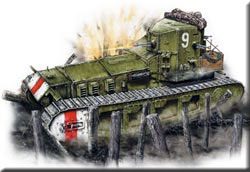 Almost immediately after the start of the use of MK tanks, the British noticed that they needed a much faster and more maneuverable tank for operations in the zone behind the line of enemy fortifications. Naturally, such a tank should first of all have great maneuverability, have less weight and reduced dimensions. The project of a relatively light tank with a rotating turret was made by W. Foster in Lincoln even before the order from the military was received.
Almost immediately after the start of the use of MK tanks, the British noticed that they needed a much faster and more maneuverable tank for operations in the zone behind the line of enemy fortifications. Naturally, such a tank should first of all have great maneuverability, have less weight and reduced dimensions. The project of a relatively light tank with a rotating turret was made by W. Foster in Lincoln even before the order from the military was received.

